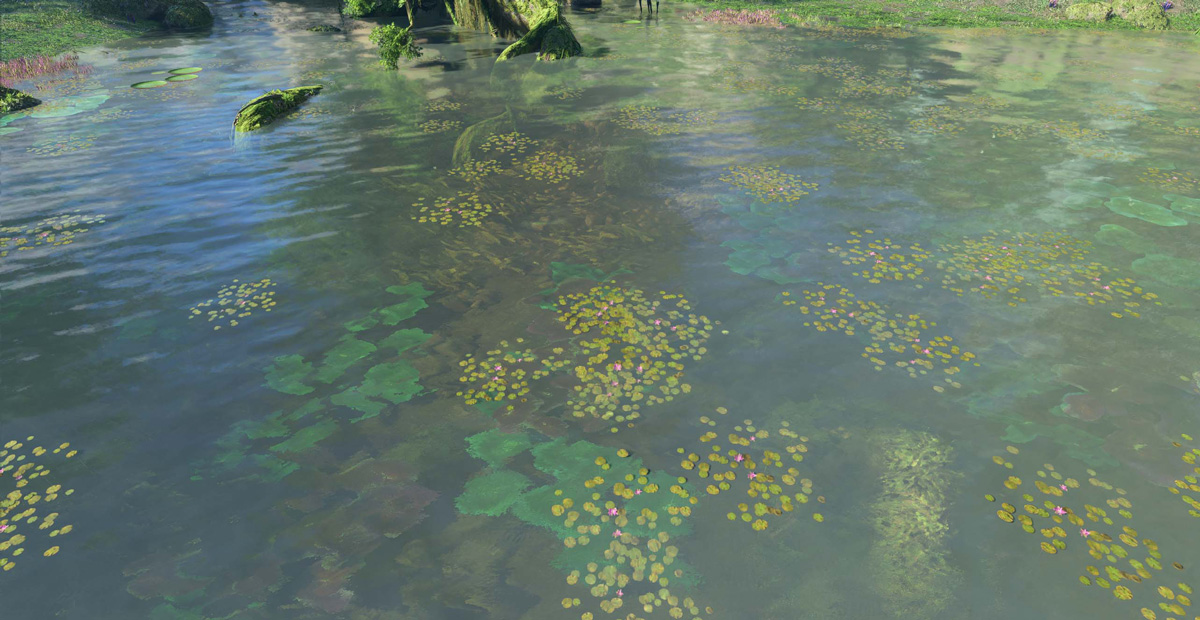The Western Frontier in Avatar: Frontiers of Pandora is a vast expanse of rainforests, grasslands and temperate forests. Building such a world by hand, placing each tree, flower and landmark would be an overwhelming task for the biggest of teams. To simplify that process, while still being able to create a believable and beautiful world, the Snowdrop engine’s scattering tool has played a vital part.
Kunal Luthra, Lead Technical Artist, David Österlind, Lead Environment Artist, and Carl Leonardsson, Senior Programmer, are three of the people that have worked on the scattering tool to help the Avatar team build an immersive Pandora.

“Simply put, the scattering system is a procedural placement tool,” David says. “It uses a node system that connects objects together in a parent-child relationship based on the radius around the objects. Maybe a tree has certain plants that grow around it, or a river has a certain type of pebbles and rocks on its banks, which in turns have certain flowers that grow around them. Once we have set up the logic we can populate the world in an instant, allowing for quick and easy iteration. It’s advanced, but the core idea is very simplistic, in the sense that everyone can grasp it.”
“We consider scattering to be the first pass,” Kunal adds. “But it’s a good first pass! When we’ve locked the scatter, we can go in and massage the content, add, remove, and move objects – adding that artist flair. And if you have an area that is extra important, where you know something important will happen in the game, artists can go in and handcraft those specific areas without using the scattering system first.”

Procedural world building tools are not new, games like Far Cry 5 have used them for a long time, but the scattering system in the Snowdrop engine was built from the ground up based on the specific needs of the project which brought a range of new innovations. After all, each procedural generation tool does things differently, based on the desired outcome. But with this level of fidelity and detail, it’s easy for the tools to bloat and become hard to use.
For artists, this tool is invaluable.”
“The scattering interface in Snowdrop is meant to be as art friendly as possible,” Kunal says when asked what improvements the team has made compared to other similar tools. “The system is not just driven by a code recipe to generate some procedural, arbitrary result. An artist can, from scratch, fill out a map based on rules, with specific assets, the child-parent relationship between objects, hierarchies, and build a nice, believable world in a user-friendly way. For artists, this tool is invaluable.”

Originally, the scatter system might have been built for Avatar: Frontiers of Pandora, but by now it has become a general Snowdrop feature that other games can benefit from.
“We did cater it for this project,” Kunal says, “to create the Pandora we wanted, but we always keep in mind how to keep it scalable and streamlined for other Snowdrop projects in the future. The more projects use it, the better and more comprehensive and advanced and easier to use it becomes.”
“It is definitely integrated into Snowdrop overall now,” Carl says. “That’s also something that we want to work more on, to make it better and easier for other projects to apply.”
Once an area has been automatically populated, it’s easy – and fast – for an artist to go in and tweak and fix things to their specifications.
“And we can scatter in layers,” Carl says. “We can place objects in layers. You might have your aquatic systems – you can have scattering at the bottom of a river, at the surface, on the cliffs next to the river, perhaps on the floating island just above it.”

It’s also important for the team behind the scattering system to be in contact with other teams, like game design, to make sure that the areas it produces fit the rest of the game.
“It might be artist driven, but it needs to go hand in hand with level design and game design, for example,” David says. “For example, interactive plants might need to have a certain distribution, or crafting materials can only be found on a certain tree with a certain type of bark. That needs to be considered as well.”
We can scatter on other assets, on props, anything really that we think should have it. That’s very powerful.”
The system is also built to be fast.
“You can have your graphs that describe the rules on one side, and the game on the other,” Kunal says. “We make an adjustment and in seconds we see the results. That’s another of its key strengths, that the iteration times are so fast – you can iterate, and iterate, and iterate quickly, and not have to wait for ages until your changes are reflected in the game.”
“When we started, we were only placing things procedurally on terrain,” Kunal says. “But now we can scatter on other assets, on props, anything really that we think should have it. That’s very powerful.”
“At the end of the day, it’s about keeping the player immersed, consistently, through the whole game. And if there are some pockets, anomalies, that we can tweak, then we do that.”
More from Snowdrop
- An Evolving Pandora, Snowdrops dynamic world
- Shining a Light on Pandora, Snowdrop’s Ray Tracing
Avatar: Frontiers of Pandora™ © 2023 20th Century Studios. Game Software excluding 20th Century Studios elements: © 2023 Ubisoft Entertainment. All Rights Reserved. Avatar: Frontiers of Pandora™ and the 20th Century Studios logo are trademarks of 20th Century Studios. Licensed to Ubisoft Entertainment by 20th Century Studios. Ubisoft and the Ubisoft logo are registered or unregistered trademarks of Ubisoft Entertainment in the U.S. and/or other countries.














